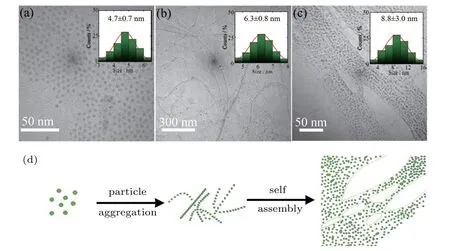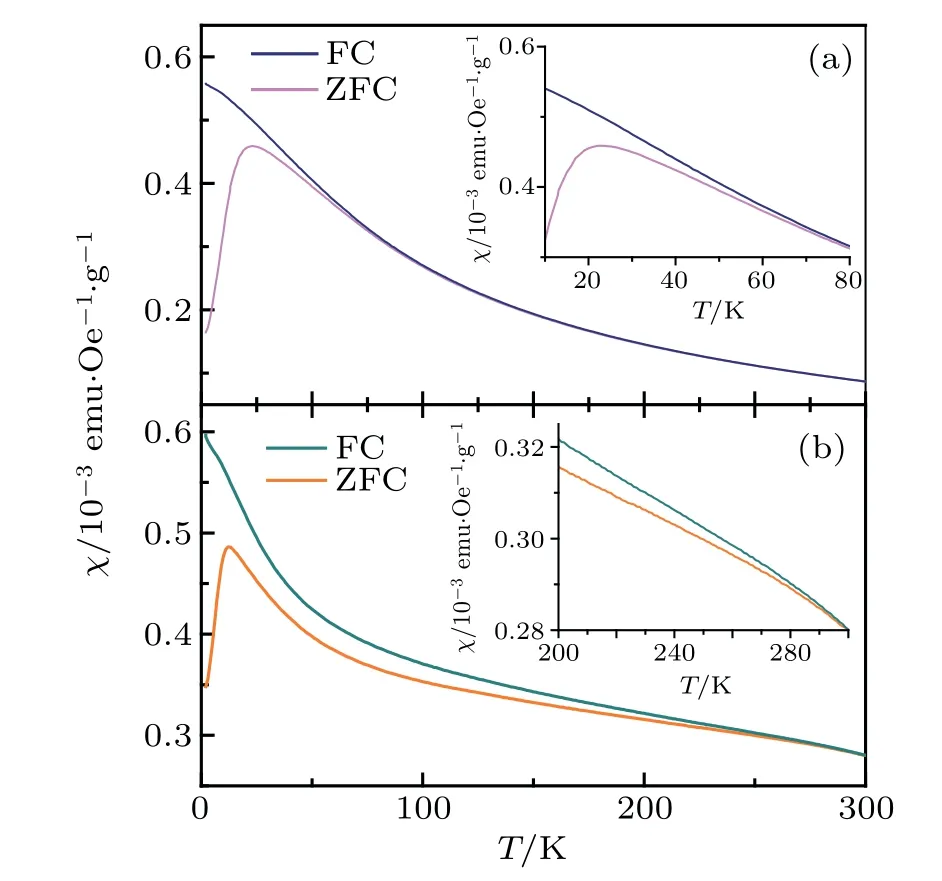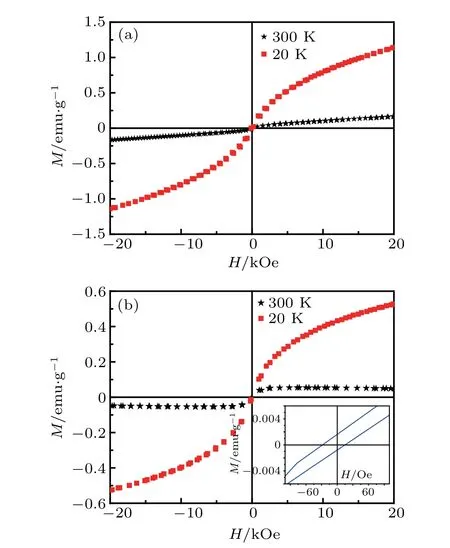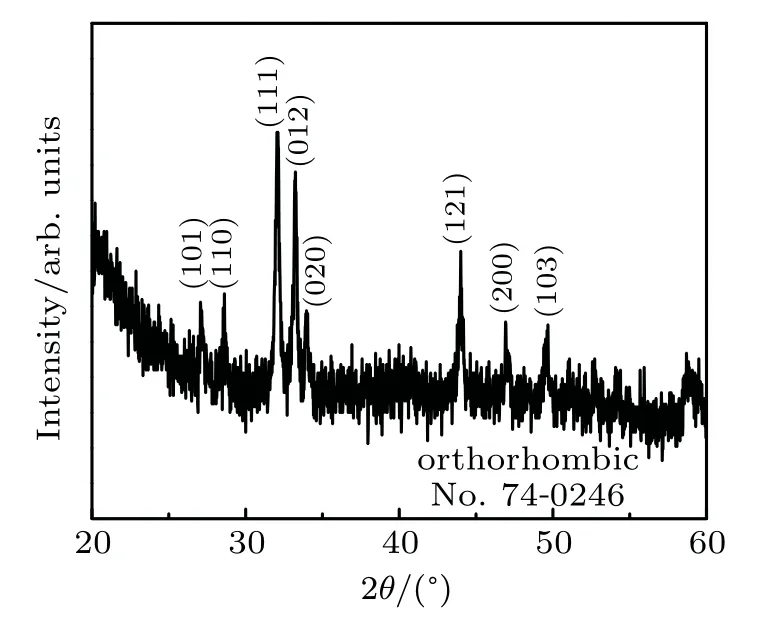Phosphine-free synthesis of FeTe2 nanoparticles and self-assembly into tree-like nanoarchitectures?
Hongyu Wang(王紅宇),Min Wu(武敏),Yixuan Wang(王藝璇),Hao Wang(王浩),Xiaoli Huang(黃曉麗),?,and Xinyi Yang(楊新一),?
1State Key Laboratory of Superhard Materials,College of Physics,Jilin University,Changchun 130012,China
2College of Material Science and Engineering,Jilin Jianzhu University,Changchun 130118,China
Keywords:self-assembly,transition metal tellurides,phosphine-free Te precursor,tree-like nanoarchitectures
1.Introduction
Transition metal telluride (TMT)nanocrystals (NCs)have received significant interest owing to their unique and excellent properties, which offer a wide range of applications in thermoelectrics,[1,2]superconductors,[3]biomedical sciences,[4,5]magnetic semiconductors,[6]and photovoltaics.[7,8]Rational modulation of TMT NCs with a tailored crystal phase,shape,size and/or assembly structure,is of high significance with respect to the engineering of the electronic,optical,and magnetic properties for the design of nanoscale devices with novel functions.Specifically,assembly of uniform nanocrystal building blocks provides a fundamental strategy for the generation of meso-and macroscale nanomaterials.[9,10]Much effort tends to take advantage of NCs as ideal building blocks for the self-assembly into one-dimensional(1D)orderd-array structures,which embody unusual properties and potential uses in both mesoscopic research and the development of nano-devices.[11–14]Many driving forces[15–28]including entropy,ligand–ligand interactions,and magnetic interaction,are contributed to the formation of self-assembly.Recently,magnetic NCs have been widely demonstrated as self-assembly blocks,which depend on the magnetic dipolar interactions of particles of a certain size.[29,30]In this respect,Xu et al.used the magnetic dipoles inherently associated with magnetic nanoparticles to form 1D assemblies of NCs.[24]However,the green synthesis and selfassembly of TMT NCs still remain great challenges.
Among of TMTs, iron ditelluride(FeTe2)is an important magnetic semiconductor with narrow band gap,which is known to exhibit 3D magnetic ordering structure.Various FeTe2nanostructures,such as quantum dots,[31]nanorods,[32,33]and nanosheets,[34]have been prepared by hydrothermal and/or solvothermal method or chemical vapor deposition over the past decade. For instance,Zhang et al. reported a hydrothermal route to prepare orthorhombic FeTe2nanorods in the presence of a certain concentration of KOH.[32]Oyler et al.have successfully fabricated FeTe2nanosheets via a hot-injection route using hexadecylamine,trioctylphosphine oxide,trioctylphosphine,telluride powder,and[Fe(CO)5].[34]Until now,great endeavors have been devoted to developing facile green synthesis techniques that fabricate TMT NCs.For this purpose,we have recently developed a new strategy for fabricating TMT NCs,e.g.,CdTe,PbTe,Cu2Te,and FeTe2NCs,by using a highly reactive phosphinefree Te precursor.[31]Despite remarkable synthesis progress in the past decades,the design and construction of the selfassembly FeTe2NCs have not yet been reported.
In this work,we report on the synthesis of FeTe2NCs with tunable sizes and their self-assemblies into the treelike nanoarchitectures by hot-injection solvothermal method using phosphine-free Te precursor. In this process, we systematically explored the formation process of tree-like FeTe2nanoarchitectures,and found that the present synthetic process is virtually a combination of oriented aggregation and self-assembly. First,FeTe2nanoparticles undergo oriented aggregation to form pearl-necklace aggregates. Second,self-assembly process takes place in the shape-defined aggregation,resulting in tree-like FeTe2aggregates. These FeTe2nanoparticles display size-dependent paramagnetic–ferromagnetic phase transition at room temperature. This microscopic magnetic behavior affects the macroscopic morphology of the FeTe2,driving the self-assembly of nanoparticles into the tree-like nanoarchitectures.
2.Experimental section
2.1.Chemical reagent
Anhydrous FeCl2(in purity 99.99%)and TeO2powder(in purity 99%)were purchased from Sigma–Aldrich. Dodecanethiol(DDT,98%),oleylamine(OLA,80%)were purchased from Alfa Aesar.Methanol,toluene and acetone were obtained from commercial sources.All chemicals were used without further purification.
2.2.Preparation of OLA–Te precursor
Typically,a mixture of DDT(2.0 mL)and TeO2powder(0.2 mmol)was loaded into a 20-mL flask and stirred for 5 min at room temperature.Then,the 2.0-mL OLA solution was injected into the mixture to obtain a black solution under a nitrogen atmosphere.
2.3.Preparation of OLA–Fe precursor
Typically, a mixture of anhydrous FeCl2powder(0.1 mmol)and OLA(5 mL)was loaded into a 50-mL threeneck flask and heated to 200?C for 10 min under a nitrogen atmosphere to obtain a clear solution.
2.4.Synthesis of orthorhombic FeTe2 NCs
At the temperature point 200?C,the OLA–Te precursor was injected into the OLA–Fe precursor.The reaction was allowed to proceed at 200?C for 60 min. Then,the mixture was cooled to room temperature naturally.The resultant NCs were isolated from the growth solution by precipitation with methanol and excess acetone followed by centrifugation for 3 min at 12000 rpm.Subsequently,the residual samples were redispersed in toluene for characterization.
3.Characterization
The transmission electron microscopy (TEM), highresolution TEM (HRTEM), high-angle annular dark-field scanning transmission electron microscopy(HAADF-STEM),and elemental mapping images were performed on a JEM-2200FS operating at an acceleration voltage of 200 kV.Composition of the specimens was analyzed with an energydispersive x-ray spectroscopy(EDX)was collected from the attachment to the JEM-2200FS.Powder x-ray diffraction(XRD)data were collected on a Bruker D8 diffractometer working with a Cu–Kα target.Magnetic measurements were carried out by a Quantum Design MPMS SQUID VSM magnetometer.
4.Results and discussion
Compared with other metal chalcogens,TMTs are much harder to be synthesized owing to the challenge of the preparation of soluble low-toxicity Te precursor.[35–39]OLA–Te,prepared by dissolving TeO2in DDT,is an efficient phosphinefree Te source for the synthesis of metal tellurides NCs in our previous works.[31]Here,we report on a strategy for synthesizing tree-like FeTe2nanoarchitectures by triggering the selfassembly of nanoparticles,in which the preparation process is divided into two parts:(i)the rapid preparation of soluble phosphine-free Te precursor,(ii)the formation of the solutionbased tree-like FeTe2nanoarchitectures(Fig.1).As indicated in Fig.1(a),when OLA was injected into the dispersion of TeO2powder and DDT,a second-magnitude redox reaction occurred with color change at room temperature.TeO2powder is reduced to the soluble(OLA)mTencomplexes,meanwhile,DDT is oxidized to disulfides.Then,we injected the preformed Te precursor into a solution of OLA–Fe precursor to synthesize FeTe2NCs at 200?C,60 min(details see the experimental section).

Fig.1.(a)Schematic diagram for the preparation of the phosphine-free Te precursor and the reaction mechanism.(b)Schematic diagram for the synthesis of FeTe2 NCs obtained at 200 ?C,60 min.
The morphology of the produced FeTe2NCs are characterized by transmission electron microscopy(TEM).Figure 2(a)shows a TEM image of the tree-like FeTe2nanoarchitectures obtained for 60 min,which have many“branches”with the average length in a range of 2μm–10μm.We observed the average diameter of the branches were about 40 nm from Fig.2(b). A higher-magnification TEM image shown in Fig.2(c)indicates that these tree-like FeTe2nanoarchitectures consist of a large number of nanoparticles with an average size of 8.8 nm. The as-prepared FeTe2NCs were examined by XRD at room temperature(25?C)in Fig.A1 in Appendix A.All diffraction peaks correspond to the crystal structure of FeTe2with the cell parameter a=3.85 ?A(JCPDS File No.74–0246).The strong diffraction peaks could be indexed to the(101),(110),(111),(012),(020),(121),(200),and(103)planes of orthorhombic FeTe2.The sharp and strong peaks also confirmed that the product is well crystallized.No characteristic peaks for impurities are observed.In addition,the chemical composition of the as obtained product was further checked by EDX(Fig.A2 in Appendix A).The element proportion(atom%)of iron to tellurium is found to be approximately 1:2 as expected(Fe:35.92%,Te:64.08%),which is in good agreement with the stoichiometric ratio of the compound of FeTe2.Furthermore,figure 2(d)demonstrates the STEM–EDS mapping images of the tree-like FeTe2NCs,in which the red region is Te elements,whereas the green region is Fe elements.The result indicates that these elements are uniformly distributed.Therefore,XRD,TEM,and STEM–EDS mapping analyses show that the pure tree-like FeTe2NCs are successfully synthesized.

Fig.2.(a)–(c)TEM images of FeTe2 nanoarchitectures for different magnifications.(d)STEM–EDS mapping of the as-prepared FeTe2 nanoarchitectures.

Fig.3. TEM images of FeTe2 NCs at 200 ?C for different reaction time:(a)10 min,(b)30 min,and(c)60 min. The insets show the corresponding size distribution histograms.(d)Schematic diagram for the self-assembly process of the tree-like FeTe2 nanoarchitectures.
In order to study the formation process of tree-like nanostructures,we track the change of sample morphology with the increasing reaction time.Figures 3(a)–3(c)show the TEM images of FeTe2that are synthesized with the reaction time of 10,30,and 60 min.In initial,these particles with the size of 4.7 nm were synthesized for 10 min,which have a high degree of monodispersity in Fig.3(a). The HRTEM image of a single nanoparticles shown in Fig.A3 in Appendix A exhibits that the fringe spacing is about 0.27 nm,corresponding to the(120)plane of orthorhombic FeTe2. When prolonging the reaction time to 30 min,larger FeTe2nanoparticles about 6.3 nm were produced and spontaneously reorganize to the“pearl-necklace”agglomerates,which have a chain length of 2μm–10μm in Fig.3(b).This result is consistent with the branch length of the tree-like FeTe2aggregates.With increasing the reaction time to 60 min,the diameters of the as-synthesized FeTe2nanoparticles increase to 8.8 nm.And nanoparticles of FeTe2were found to self-assembled into the tree-like aggregates as shown Fig.3(c).A schematic illustration of the growth and self-assembly process of the tree-like FeTe2nanocrystals at different reactions intervals is given in Fig.3(d).
To further inspect the self-assembly behavior of FeTe2nanoparticles,we investigated magnetic properties of the samples with different particle sizes.The temperature dependence of magnetization measured in an applied field of 1000 Oe(1 Oe=79.5775 A·m?1),clearly sheds light on the magnetic properties of these FeTe2NCs(Fig.4).From the zero-fieldcooled(ZFC)and field-cooled(FC)curves of 4.7-nm nanoparticles obtained by the reaction time of 10 min,it can be seen that the magnetization measurements show paramagnetic behavior above 75 K(Fig.4(a)).Therefore,these particles obtained under this condition have good monodispersion.In contrast,the zero-field-cooled(ZFC)and field-cooled(FC)curves of FeTe2obtained for 60 min are closed until 300 K(Fig.4(b)),which indicates that the as-prepared tree-like FeTe2NCs are ferromagnetic at room temperature.

Fig.4. Temperature dependence of FC and ZFC susceptibilities for(a)4.7 nm and(b)8.8 nm FeTe2 NCs.
To gain further insight into the magnetic properties of the synthesized 4.7-nm and 8.8-nm FeTe2NCs,the magnetization dependence on the applied magnetic field(hysteresis loop)has been recorded at 20 K and 300 K(Fig.5). The loops indicate that the 4.7-nm and 8.8-nm FeTe2NCs both have ferromagnetism at 20 K.At 300 K,4.7-nm FeTe2NCs show the paramagnetic behavior,whereas 8.8-nm FeTe2NCs still display ferromagnetic behavior with the coercive force of about 22 Oe. It is in good agreement with the result of the ZFC–FC curves.Thus,we suggest that FeTe2NCs have the sizedependent magnetic properties.With the increasing reaction time,the diameters of the as-synthesized FeTe2nanoparticles increase from 4.7 nm to 8.8 nm and spontaneously reorganize to the tree-like aggregates. Therefore,the magnetic interaction is thought to be the driving force of nanoparticle selforganization.

Fig.5. The hysteresis loop of the synthesized(a)4.7-nm and(b)8.8-nm FeTe2 NCs at 20 K and 300 K.The inset of panel(b)is the region around the zero field of the hysteresis loop.
5.Conclusion
In summary,we have proposed a facile way to fabricate FeTe2NCs using highly reactive phosphine-free Te precursor by hot-injection solvent thermal method. We systematically explored and found that the formation process of treelike FeTe2nanoarchitectures is a combination of oriented aggregation and self-assembly. Initially,the FeTe2nanoparticles with a high degree of monodispersity are formed after nucleation.Subsequently,the FeTe2nanoparticles undergo oriented aggregation to form the“pearl-necklace”agglomerates.Then,these“pearl-necklace”agglomerates spontaneously assemble into the tree-like nanoarchitectures.The magnetization measurements show the size-dependent magnetic properties of FeTe2NCs,driving the self-assembly of nanoparticles into the tree-like aggregates. This work provides a simple green approach to integrate FeTe2NCs with self-assembly behavior,which is suitable for subsequent processing into quantumconfined superstructures,materials,and devices.
Appendix A:Supporting information
Some figures are given in the following to provide supporting information for better understanding the text.

Fig.A1. XRD characterization of orthorhombic FeTe2 prepared for 60 min.

Fig.A2.EDX spectrum of the as-prepared FeTe2 NCs.

Fig.A3.HRTEM image of the as-prepared FeTe2 NCs.
- Chinese Physics B的其它文章
- Theoretical analyses of stock correlations affected by subprime crisis and total assets:Network properties and corresponding physical mechanisms?
- Influence of matrigel on the shape and dynamics of cancer cells
- Benefit community promotes evolution of cooperation in prisoners’dilemma game?
- Theory and method of dual-energy x-ray grating phase-contrast imaging?
- Quantitative heterogeneity and subgroup classification based on motility of breast cancer cells?
- Designing of spin filter devices based on zigzag zinc oxide nanoribbon modified by edge defect?

